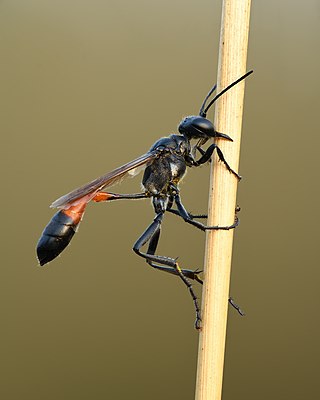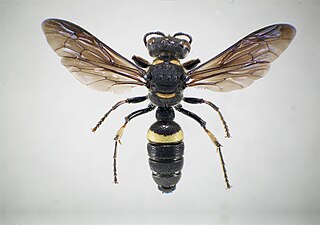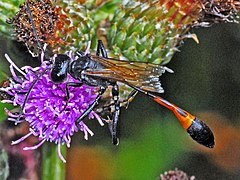
The Sphecidae are a cosmopolitan family of wasps of the suborder Apocrita that includes sand wasps, mud daubers, and other thread-waisted wasps.

Mud dauber is a name commonly applied to a number of wasps from either the family Sphecidae or Crabronidae which build their nests from mud; this excludes members of the family Vespidae, which are instead referred to as "potter wasps". Mud daubers belong to different families and are variable in appearance. Most are long, slender wasps about 1 inch (25 mm) in length. The name refers to the nests that are made by the female wasps, which consist of mud molded into place by the wasp's mandibles. Mud daubers are not normally aggressive, but can become belligerent when threatened. Stings are uncommon.

Sceliphron, also known as black mud daubers or black mud-dauber wasps, is a genus of Hymenoptera of the Sphecidae family of wasps. They are solitary mud daubers and build nests made of mud. Nests are frequently constructed in shaded niches, often just inside of windows or vent openings, and it may take a female only a day to construct a cell requiring dozens of trips carrying mud. Females will add new cells one by one to the nest after each cell is provisioned. They provision these nests with spiders, such as crab spiders, orb-weaver spiders and jumping spiders in particular, as food for the developing larvae. Each mud cell contains one egg and is provided with several prey items. Females of some species lay a modest average of 15 eggs over their whole lifespan. Various parasites attack these nests, including several species of cuckoo wasps, primarily by sneaking into the nest while the resident mud dauber is out foraging.

The organ pipe mud dauber is a predatory wasp in the family Crabronidae.It is fairly large, ranging from 3.9–5.1 cm, and has been recorded to fly from May to September. Females and males are similar in colour, a shiny black, with the end part of the back leg being pale yellow to white. The organ pipe mud dauber feeds mainly on three genera of spider: Neoscona, Araneus, and Eustala. Melittobia, a parasitoid wasp, is a common ectoparasite of T. politum prepupae. Other sources of parasitism include the bombyliid fly Anthrax, chrysidid wasps, and various species of scavenger flies (Miltogramminae). The tufted titmouse is a known predator of T. politum, and may feed on them more commonly than previously thought, as the holes made by the titmouse are similar in shape and size to those made by T. politum leaving the nest after pupation.

Bembix rostrata is a species of sand wasp native to Central Europe. The genus Bembix - of which B. rostrata is among the most distinctive species - has over 340 species worldwide and is found mostly in warm regions with open, sandy soils; Australia and Africa have a particularly rich variety of species.

A wasp is any insect of the narrow-waisted suborder Apocrita of the order Hymenoptera which is neither a bee nor an ant; this excludes the broad-waisted sawflies (Symphyta), which look somewhat like wasps, but are in a separate suborder. The wasps do not constitute a clade, a complete natural group with a single ancestor, as bees and ants are deeply nested within the wasps, having evolved from wasp ancestors. Wasps that are members of the clade Aculeata can sting their prey.

Sphex ichneumoneus, known commonly as the great golden digger wasp or great golden sand digger is a wasp in the family Sphecidae. It is identified by the golden pubescence on its head and thorax, its reddish orange legs, and partly reddish orange body. This wasp is native to the Western Hemisphere, from Canada to South America, and provisions its young with various types of paralyzed Orthoptera.

Cerceris fumipennis, the only species of buprestid-hunting Crabronidae occurring in eastern North America, is found throughout the continental United States east of the Rockies: from Texas and Florida north to Maine, Wyoming, and into Canada. The wasps most often nest in open areas of hard-packed sandy soil surrounded by woody habitat suitable for their buprestid beetle prey.
The thin-waisted social wasps, which typically reside in Neotropical regions from Central to South America, are a small genus of wasps that build nests and live in colonies ranging in size from 1 to 18 members. Microstigmus is widely considered to be the only true eusocial species within the family Crabronidae. Like all Hymenoptera, Microstigmus has an interesting sex determination pattern. Females are 2n (diploid), spawning from eggs that have been fertilized, while males are 1n (haploid) and spawn from unfertilized eggs. Female wasps contain the eggs within their egg sac and have the option of fertilizing them or not, thus having complete control of the gender of their offspring. This wasp genus, part of the suborder Apocrita, is distinguished physically by the narrow waist (petiole) between the end segment of the thorax (mesosoma) and the beginning of the abdomen (metasoma). Specifically, it is in the subgroup of "apoid wasps", those that exhibit social behavior in nesting and foraging. Evidence does exist that in some species social altruism is visible; however, studies on these topics have been limited. The small size and enclosed nest structure makes it difficult to obtain significant data. Although it was originally classified under the Sphecidae family due to its elongated petiole, Microstigmus has been reclassified into the new Crabronidae family.

Cotesia glomerata, the white butterfly parasite, is a small parasitoid wasp belonging to family Braconidae. It was described by Carl Linnaeus in his 1758 publication 10th edition of Systema Naturae.

Ammophila urnaria is a species of hunting wasp in the family Sphecidae. It is a black and red insect native to the eastern United States. It feeds on nectar but catches and paralyses caterpillars to leave in underground chambers for its developing larvae to consume.

Anoplius viaticus, commonly known as the black-banded spider wasp, is a species of spider wasp. These wasps are known as spider wasps because the females capture spiders to provide their offspring with food. The paralysed spider is cached in a burrow, the wasp lays an egg on it, and when this hatches, the developing wasp larva consumes the spider. This species is found in sandy heathland across most of Europe.

Podalonia hirsuta is a species of parasitoidal wasps in the family Sphecidae.

Sphex funerarius, the golden digger wasp, is a species of digger wasp of the family Sphecidae.

Tachytes is a genus of predatory, solitary wasps, containing about 300 species.

Meringopus calescens is a species of wasp belonging to the family Ichneumonidae first described by Johann Ludwig Christian Gravenhorst in 1829.

Cerceris rybyensis, the ornate tailed digger wasp, is a Palearctic species of solitary wasp from the family Crabronidae which specialised in hunting small to medium-sized mining bees. It is the type species of the genus Cerceris and was named as Sphex rybyensis by Carl Linnaeus in 1771.

Ammophila procera, the common thread-waisted wasp, is a species of thread-waisted wasp in the family Sphecidae. It is a common species, found in southern Canada, the United States, and Mexico, and south to Central America.

Palmodes occitanicus is a species of thread-waisted wasp in the family Sphecidae.

Sceliphron asiaticum is a species of thread-waisted wasp in the family Sphecidae. It is native to the Neotropics, South America and the Caribbean region.





















